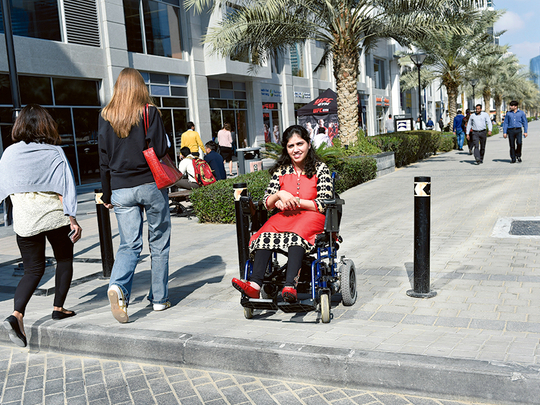
Dubai: At the age of 24, Sharan Budhrani, a Dubai resident, suffers from muscular dystrophy, a neuro-muscular disease that is progressively deteriorating and at present has no known cure. Although Budhrani still has sensation in his legs, he had lost the ability to stand on them by the time he was 18 years old. “My legs started to feel heavier and I was unable to walk normally. I sat in a wheelchair for the first time when I was 18. [Initially], I felt embarrassed about it,” said Budhrani, his shy demeanour unmistakeable. Today, he uses his electric wheelchair with panache to get around. An active individual, Sharan works at his family-run business, where he helps his parents in any way he can.
Budhrani believes that Dubai has made it quite easy for individuals with special needs to remain mobile and access public places though getting on to pavements is still a challenge, especially in the older parts of the city. To avoid having to wheel himself around on the road, Budhrani has to plan his trips in advance. Gulf News took a stroll with him in his neighbourhood in a Deira area and realised that if he needed to go along the pavement for a few blocks, it was difficult because not every stretch of pavement had a ramp to facilitate getting on and off to the next stretch. To be able to go along the stretch of blocks, he would have to get down the pavement to the road every time it ended.
However, Budhrani has not faced any issues using facilities at malls or in public buildings and finds chores such as using rest rooms in malls relatively hassle-free.
Despite his ordeal with pathways, Budhrani has a lot of positive things to say about the ease with which he can use the Dubai Metro, which he finds to the best way to get around.
“I use the metro regularly,” he said. “It is easy [to use] ... offers easy access,” he says.
For Bindiya Farswani, a 31-year-old Dubai resident from India, who is wheelchair bound due to cerebral palsy quadriplegia, a condition wherein normal brain activity is disrupted, the Dubai Metro is a boon.
However, she finds getting to the metro to be a challenge. Although Business Bay metro station is about a 10 minute walk away from her house the difficulties she faces getting on and off pavements forces her to be (Due to the difficulties she faces getting on and off pavements, she is) driven by car to the metro station by family or friends. “I use the roads when I have to get somewhere, not the walkways,” she says. Farswani’s outgoing personality takes her to the park and restaurants near her building regularly however, her mum has had to purchase a metal foldable ramp from abroad to allow her to be able to access these areas. The heavy ramp has to be carried by someone when Farswani goes on these trips or carried in the car when they go elsewhere in the city – just in case.
Although Bindiya has problems with pavements and their lack of ramps, the Farswani family are happy with the changes and improvements throughout the city over the last 10 years. Although there are some challenges yet, getting around the city and going to public areas has become much easier in Dubai, they said.
The observations of Budhrani and Farswani are a reflection of how committed Dubai is to meet its goal of being the most disabled-friendly city by 2020 based on the Dubai Disability Strategy 2020. Over the years, a number of initiatives have been launched to make the emirate more access-friendly for individuals with disabilities, and with Expo 2020 only four years away, there are increasing initiatives being implemented to arrive at the goal as soon as possible.
The government of Dubai and its many entities such as the Ministry of Public Works, Dubai Municipality and Roads and Transport Authority, for example, are playing instrumental roles in setting up regulations and guidelines across the city to ensure people with disabilities enjoy the same ease of getting around as do other residents. The government’s efforts cover access to all parts of the city, from public transport to parks and buildings.
So, what has been implemented in the city so far, what are the plans and what are some of the challenges that people with disabilities still face in Dubai?
Gulf News brings you an overview.
Dubai Municipality
Dubai Municipality Building Regulations, which are in line with the Ministry of Public Works codes and regulations, must be followed in construction. They provide detailed guidleines on facilities and access that have to be provided for people with disabilites. The compliance with the regulations are monitored and audited throughout the different stages of the building’s design. This is necessary to obtain the relevant construction permits as well as receiving the final completion certificate.
Dubai Municipality confirmed to Gulf News, “The requirements of persons with disabilities are authentic requirements and must be adhered to in all buildings. Therefore any violation in this regard is punishable... according to the stipulated [laws] in the Regulation of Construction Works in the Emirate of Dubai.”
While meeting the regulations are compulsory for new buildings, they do not apply to existing structures and facilities. However, the municipality is working hard to find a solution to this issue.
“Dubai Municipality has laid down plans to follow up rehabilitation of the existing public buildings with their owners and those who are responsible for managing them, to facilitate the requirements of persons with disabilities, and generally the development of the municipal services itself to fit the needs of [this segment of society] and their safety,” said a Dubai Municipality spokesperson.
Community initiatives include Hadreen, which aims to serve the elderly and people with disabilities by going to their place of residence and providing the Building Department services to them in their homes, are being developed.
The guidleines, which are regularly reviewed and updated, set standards for:
Urban design considerations including obstructions, signage, street furniture, pathways, curb ramps, pedestrian crossing and parking.
- Architectural design consideration including ramps, elevators, lifts, stairs, railing and handrails, entrances, vestibules, doors, corridors and rest rooms.
- Building types are broken down into different categories with considerations included for design of any building such as general, residential buildings, office buildings, hotels, educational buildings, libraries and sports buildings. There are also suggestions included for existing and historic buildings.
For each item clear recommendations have been made, some of which include:
1. Resting facilities placed at regular intervals, outside main circulation path in front of accessible entrances and exits and wherever necessary. The resting spaces with benches should allow a minimum of (120cm) of adjoining space for a wheelchair.
2. Curb ramps should not obstruct the free passage of people with physical disabilities, mainly wheelchair users.
3. Pathway edges should be bevelled wherever changes in level between (0.6 and 1.3 cm) exist between the pathway and the surrounding area.
4. Pedestrian traffic lights should be provided with clear audible signals for the benefit of people with visual disability.
5. Provide accessible parking facilities as close as possible to the point of destination.
6. Recommendations made on what slopes of ramps should be in relation to its distance.
7. Generally, a turning circle of 150cm diameter is recommended inside the rest room to allow manoeuvring of wheelchairs.
8. In any public rest room at least one unisex compartment should be accessible to a wheelchair user.
Dubai Municipality confirmed that not only all its parks are fully equiped to provide access for people with disabilities they are also free of charge for them. Examples include; Dubai Glow Garden and Children’s City.
The municipality, along with RTA, Dubai Smart Government and other stake holders are working closely on a Universal Accessibility strategy that is expected to be complete by the end of 2016. It is expected that a list of recommendations and perhaps new guidelines will be issued following their review of all existing regulations and facilities.
RTA
Travelling around a city can often be a daunting task for people with disabilities, whether it is by public transport or getting around by foot and wheelchair.
RTA told Gulf News that it has placed Corporate Social Responsibility (CSR) as a priority and it “is keeping on providing developed services to an important social segment in the UAE; the disabled’s [needs] and requirements have always been embedded in RTA’s development plans and services,” a spokesperson said.
RTA has taken steps to ensure facilities and services provided by their departments and agencies cater to the requirements of people with special needs. The departments under RTA include Rail Agency, Card Services Department, Public Transport Agency, Traffic and Road Agency, Licensing Agency, Dubai Taxi and Customer Services.
Each department has implemented a series of services to ensure what they offer is easily accessible for people with disabilities. The list of services implemented is long, but a short summary of some of these include:
Rail Agency
1. Tactile floor paths to guide people who are visually impaired at rail stations.
2. All ticket-selling booths are designed to be accessible by wheelchair users.
3. CCTV for people who have impaired hearing.
4. Special bathroom facilities for people with disabilities.
5. Audio notices for people who are visually impaired.
6. Special spaces at all rail facilities for wheelchair users.
7. Audio-visual cautionary signs upon opening and closing of platform screen doors.
8. Parking provision for people with special needs near the main station entrances.
Card Services Department
NOL personalised card for people with disabilities which allows free travel using Dubai Metro and public buses in Dubai City.
Public Transport Agency
New buses with facility to lower the floor level to enable access.
Water buses can accommodate up to three wheelchairs and have crew to assist with entry to boat.
Ferry Dubai can accommodate two wheelchairs.
Traffic and Roads Agency
Pavement height is lowered in the proximity of junctions or cross points.
Construction of pedestrian crossings between the two ends of the road such that there will be no height difference.
Footbridges with lifts.
Auditing the designs of the new parking lots to ensure availability of disabled parking
Free parking for people with disabilities.
Free Salik tag for people with disabilities.
Licensing Agency
Preparation of vehicles for people with disabilities; It is a service whereby the client is briefed on the accessories required to be provided in vehicles for disabled drivers or vehicles of the disabled, along with the companies that provide these accessories.
The vehicles are then tested and officially endorsed by the Vehicles Licensing Department as a vehicle designated for the disabled
Dubai Taxi
Operating seven special taxis to meet the needs of the disabled 24 hours a day covering all areas of the emirate. Vehicles are fitted with special lifts for wheelchairs, artificial respiratory systems, wheelchair on board and seats for companions.
Customer Service
Seats for people with disabilities at the main entrance of some Customer Service Centres (Umm Ramool, Deira Licensing, Al Barsha).
Provision of fast track queue for people with disabilities.
Sharan Budhrani: Older buildings without ramps pose a challenge
Earlier, the building in which Sharan Budhrani, 24, who suffers from muscular dystrophy, has his apartment did not have an adequately built ramp that enabled him to wheel himself into the lobby. It was a daily challenge to be able to get inside. So, his family, along with Budhrani, approached the landlord and the latter was extremely receptive to their concerns and quickly installed a ramp at the entrance of the building for him.
Sharan finds it relatively easy to get around in Dubai and access most of the newly built areas. It’s the older parts of the city that he finds to be a challenge. “Access to footpaths is very difficult, specially in the older parts of the city,” said Budhrani.
A shy individual by his own admission, Budhrani nevertheless decided to write to the RTA to highlight his concerns - getting on and off a number of pavements in areas near his building which he frequented in order to get to the metro station.
“I didn’t know if they would reply… after about three months, they sent me a reply with a proposal of work they wanted to do that would solve my problem,” he said. “When I got their reply, I was very happy. The RTA authorities even proposed putting in a pedestrian crossing which I wasn’t expecting.”
Budhrani replied to the RTA that he was satisfied with their plans and the work went ahead. Today, he finds going to the areas to be problem-free and hopes that similar kind of facilities can be implemented around the city to help him and other people in wheelchairs navigate their way more comfortably. His positive experience with RTA prompted him to further advise them of a few more areas he needed help with, and again they came up with a plan and modified the pavements.
Other challenges for Budhrani include accessing restaurants and public buildings, even those that have existing. “Most regular restaurants, not the big restaurants, are not accessible. They have steps in front of them and I have to ask people to lift me and my wheelchair,” said Budhrani. His heavy electric chair requires around three people to lift it.
“So I always try and go to places where I can sit outside,” he said and confessed that he does not want to bother strangers and ask for their help.
According to Budhrani, the older public buildings in Dubai do not have a ramp and the ones that do, have ramps that are too steep for him. “I think they are designed for trolleys, not for wheelchairs. It can be very difficult to use them.”
As for taxis for the disabled, he once ordered a taxi with specially fitted features but it arrived over an hour late so he did not order them again. “I think it is because there are only a few of them [taxis],” he said.
Bindiya Farswani: Reaching Metro is hard, but the ride is easy
Bindiya Farswani, Indian, is a 31-year-old Dubai resident with cerebral palsy quadriplegia, a condition wherein brain damage disrupts normal brain activity. Bindiya, who was born with the condition, has to use a wheelchair at all times.
An active woman who enjoys writing, modelling, poetry and, more recently, dancing, she jokes that if it were up to her, she would be out all the time. She only stays home, she said, to be with her mum. Her positive spirit is infectious and she jumps at the chance to show Gulf News her neighbourhood and what she enjoys doing there. She heads towards an area with a small park and a group of restaurants which she enjoys frequenting. A metro station can be seen about a 10-minute walk away.
Bindiya confirms Sharan’s observations about the ease of metro usage. However, getting to the metro station is a different story, she said.
Gulf News attempted to get to the metro station with her however, the rather challenging journey involved driving towards oncoming traffic which dissuaded us to stop and return not long after we had begun.
Due to the difficulties she faces getting on and off pavements, she is driven by car by one of her parents to the metro station. “I use the roads when I have to get somewhere, not the walkways,” she said.
Bindiya said she had too many experiences of getting onto the pavement and then not being able to get off it and having to return to her starting point. So she no longer takes the risk of getting on to pedestrian pathways. Her mother, Rakhee, does her best to drive her to most destinations in their specially modified car, to prevent Bindiya from getting on to the road.
Her mother had initially purchased foldable metal ramp from a trip abroad which she would use to help the wheelchair get on and off the pavement but it was too heavy and impractical to be lugged about on a daily basis. It also failed to be of any use on some of the pavements that were too high and presented a steep climb for Bindiya.
Like Sharan, Bindiya, too, struggles getting into restaurants. “Restaurants either have steps or they are located in a manner that [is difficult for] a wheelchair to access,” she said. Despite that she goes to a few of her favourite restautants in Karam armed with the metal foldable ramp just so she can enjoy a meal.
She hopes restaurants in Dubai will invest a little and install ramps.
As an active person with a love of the outdoors, Farswani hopes to one day be able to go out in her wheelchair without the constant stress of wondering whether she will be able to get to her destination or not.








